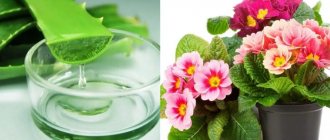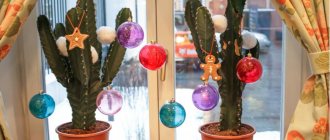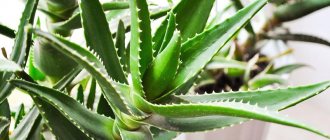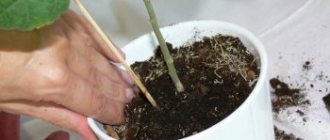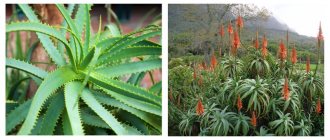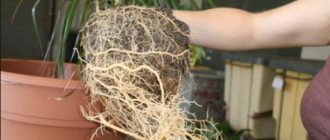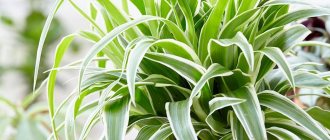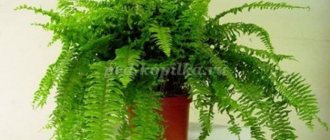Descriptions and photographs of plants similar to aloe
A characteristic feature of aloe-like plants is their fleshy, elongated leaves, collected in a dense rosette.
Agave
Agave is a stemless perennial from the Asparagus family native to Mexico, North and Central America. Agave leaves are large, fleshy, widened or narrowed, forming a dense rosette. A hard point is formed at the ends. Most species are equipped with straight or curved spines along the edge.
The color of agave leaves is grayish, green or bluish-green. The leaves of some agave species are decorated with yellow or silvery-white thread-like stripes. The surface of the leaf plate is covered with a rich waxy coating.
Under natural conditions, agave blooms once every 10-15 years. A spike-shaped or paniculate inflorescence with many yellowish flowers is formed on a high peduncle. After flowering, the plant begins to age sharply and soon dies.
Hehtia
Hechtia is a terrestrial bromeliad, close to succulent plants. Hechtia is native to Central America and Mexico. Hechtia Texasa is similar to aloe. Its leaves are long, fleshy, pointed, hard, notched along the edges, with sparse spines. The leaves form a dense, dense rosette with a diameter of about 50 centimeters.
Hechtia blooms inconspicuously: small flowers of white, greenish, pink or red-burgundy colors are collected in small spikelets.
Bergeranthus
Bergeranthus is a plant that is not very common in our country, and mostly true lovers and connoisseurs of succulents are familiar with it. Bergeranthus is native to South Africa. Under natural conditions, this succulent forms clumps that stretch for many kilometers.
Of the 12 plant species, two are grown indoors:
- Bergeranthus polycapita. The leaves of this species are smooth, collected in rosettes of up to 10 pieces each, tightly pressed to each other. The shape of the leaves is an elongated triangular prism 6 centimeters in length, pointed at the end. The plant blooms with yellow, single flowers with a diameter of 3 centimeters.
- Bergeranthus arrowhead. The leaves are dark green. evenly colored. about 10-12 centimeters in length, wide at the bottom and tapering at the ends, 10 centimeters in length. There are serrations along the edge of the leaf. The flowers are orange-yellow, on long stalks like a cactus.
Ariocarpus
Ariocarpus is a cactus with leaves resembling aloe. The plant mainly lives in Mexico, where it thrives during the rainy season and hides in the soil during periods of drought. It is distinguished from cacti by its very unconventional appearance.
Ariocarpus is a thornless cactus. The fleshy, triangular-shaped leaves are covered with warty bumps and projections. The surface of the leaves looks like reptile skin. In nature, Ariocarpus blooms with large flowers of red, white or yellow. At home, flowering is extremely rare.
Sansevieria
Sansevieria is a stemless perennial of the agave family native to Africa. India, Indonesia and other Asian countries. This plant, popular in indoor floriculture, is also called “pike tail” or “mother-in-law’s tongue.”
Sansevieria is a plant with succulent, dark green, lanceolate-shaped leaves that form a dense, dense rosette. Powerful leaves grow up to 120 centimeters in height. Depending on the variety, the leaves of the plant are complemented by contrasting edging or vertical and horizontal stripes of a darker tone.
Faucaria
Faucaria is a succulent from the Aziz family native to South Africa. Translated from Latin, the name of the plant is translated as “mouth” (“faux”) and “many” (“αρι”).
The plant received this name because of the shape of the leaves, which are equipped with sharp white growths along the edges, similar to the teeth of a predator. The leaves are collected in rounded rosettes. Each rosette consists of 3-6 pairs of leaves growing crosswise.
Faucaria blooms with single flowers with a diameter of 6-7 centimeters. The thin petals of the flowers are painted in various shades of yellow. Flowers are open only during the day, and at night they fold their petals, turning into a bud. Each flower lives on the plant for about a week.
Gasteria
Gasteria is a succulent of the Asphodelaceae family native to the deserts of South Africa. Gasteria leaves are shortened, fleshy, dark green with a slight waxy coating. Brown or silver stripes run across the leaves. There are species with white specks that densely cover the leaves.
Gasteria blooms with flowers of medium size (2-2.5 cm in diameter) and pink flowers. Orange, white or red color. Flowers are collected in racemes or panicles formed on an oblong peduncle.
Haworthia
Haworthia is an unusually beautiful plant from the steppes and deserts of South Africa. There are more than 150 species of Haworthia, differing in appearance and leaf color: blunt and fleshy, sharp and thin, covered with small spines, yellow, silvery stripes or white pimples that look like raised warts.
The leaves of the plant form a symmetrical, beautiful rosette with a diameter of up to 30 centimeters. The leaves grow very densely. Haworthia is similar to an aloe or miniature agave. When grown at home, the plant almost never blooms.
Aloe - 11 popular species for growing at home
Surely since childhood you have been familiar with the domestic representative of the Xanthorrhoeaceae family, and also with the medicinal Aloe.
This succulent grows in many homes, its distinctive feature being fleshy leaves framed by thorns, arranged in a spiral in densely collected rosettes. In the wild, there are about 500 species of plants growing in hot regions - Africa, the Mediterranean and Arabia. These species are very different in appearance; there are real giants - trees reaching a height of up to 20 meters. There are Liana-like Aloe and shrubs with long, about half a meter, spreading leaves. Decorative species of certain varieties grow in our homes. You can find out about the main ones in this article.
Aloe tree (Aloear borescens) - better known as Agave
At home, with proper care, it can grow up to 1 meter; in nature, there are representatives up to 5 meters in height. It has smooth fleshy leaves, greenish-blue in color, with teeth along the edges. In indoor conditions, the plant almost never blooms, but in nature, during the winter seasons, large reddish flowers with a pleasant aroma appear. Read more about the medicinal properties of agave
Aloe Tree juice has antibacterial, anti-inflammatory and regenerating properties. If you accidentally cut yourself or burn yourself, you can anoint the wound with the juice of the plant, or apply a piece of pulp.
Aloe arborescens (Agave) / Aloe arborescens in nature
Aloe aristata (Aloe aristata)
This species is often confused with Haworthia due to their similar appearance. This plant has thick, arched leaves with a rough surface and white spots. At the end of the leaf there is a characteristic white thread. It usually blooms in late spring with red and orange tubular flowers collected in a raceme (Haworthia has white flowers).
To distinguish Aloe spinosa from Haworthia, you need to pay attention to the fact that Aloe is a solitary plant, and Haworthia has lateral children. Also, Aloe has a less pronounced pattern and convexity on the leaves. An adult Haworthia plant is small in size, in contrast to Aloe Spinata.
Aloe squat (Aloe humilis)
A small herbaceous plant, with dense groups of spines along the edges of the leaves, and a large number of papillae on the outer side. The leaves have a linear-lanceolate structure. Throws out a long peduncle (20-30 cm) with red or orange flowers.
Aloe squat / Flowering
Aloe Vera
Like Scarlet Tree, it has medicinal properties. It is distinguished by fleshy leaves with a high water content (97%). The leaves have pale white patches. The composition of this species is very rich in minerals, amino acids, enzymes and beta-carotene. Actively used in cosmetology and medicine. In care, a moderate watering regime should be observed.
Aloe variegata - Tiger Aloe
It has dark green smooth leaves with a characteristic tiger pattern. Differs in slow growth. You need to be careful and moderate when watering so that water does not fall on the plant (this can lead to rot and death of the plant). You should also carefully accustom the plant to direct sunlight (it is very sensitive), and it is better to arrange shading if you have a south window. Flowering with red-orange inflorescences.
Aloe squarrosa
A representative with leaves no more than 10 cm, greenish-yellow in color, with oblong white spots, and teeth along the edges. At home it almost never blooms. Particularly unpretentious and grows quickly. Can be planted in compositions with other types of succulents. Excellent propagation by vegetative means.
Aloe protruding
Aloe plicatilis (Aloe plicatilis)
An interesting species, it is distinguished by a forked stem, on which up to 16 fan-shaped, fleshy leaves can fit. It has a dull green color. The leaves grow no more than 30 cm. In its native conditions it grows on rocky mountain slopes, reaches sizes of up to 5 meters, and resembles a shrub or small tree.
Aloe foldata
Aloe erinacea
It has dense dark green leaves with sharp thorns. As they mature, the tips of the leaves and spines darken. The plant is small, bushy. In nature it blooms with tubular flowers of red and yellow colors. There are species with white spines; in some, the spine length can reach 1.5 cm.
Aloe hedgehog
Aloe jucunda
A very attractive species with bright green serrated leaves adorned with white spots. After a couple of years of life, the plant begins to bloom with small pink flowers, in inflorescences of 20-30 flowers. Begins to bloom in spring and continues into summer. It grows from several rosettes and grows beautifully.
Aloe Jucunda / Flowering
Aloe Polyphylla - Aloe Spiral
A very beautiful species, with fleshy, triangular, pointed leaves arranged in a spiral. Flowering only in natural habitat - long peduncle up to 60 cm) with pink, rose-red or yellow flowers. The number of leaves per rosette, as a rule, is no more than 30 pieces. Quite a rare species. The spiral can grow clockwise or counterclockwise.
Aloe Spiral
Aloe albiflora
The species is small in size with narrow serrated leaves of gray-green color. There are light blotches on the leaves. At home, it blooms in winter (with proper care throughout the year) with white inflorescences that look like elongated bells with green shelves. Growth is slow, not whimsical. Tolerates partial shade well.
Aloe-like flower
Aloe is the common name for succulent (water-storing) plants belonging to the family Asphodelaceae or Liliaceae. Aloe is characterized by fleshy, succulent leaves. Most plants have thick and soft spines.
The plants are distributed mainly in Africa, namely in South Africa, Madagascar, the Mascarene Islands, and the southern part of the Arabian Peninsula.
There are about 400 species of aloe. Many species of this plant are unpretentious and get along well at home. Also, almost all types of aloe are well suited for growing in winter gardens and take root well next to other plants, which allows them to be used in various plant compositions.
Pest and disease control
Even the most unpretentious varieties are not protected from problems. Although succulents are almost of no interest to pests and parasites. Mites, thrips and mealybugs are sometimes found. To combat them, use acaricides and systemic drugs.
It is recommended not only to spray the plant, but also to saturate the soil. This way the leaves and stems will become poisonous to parasites from the inside. To prevent the roots from rotting, avoid frequent watering and choose admixtures with a reduced nitrogen content.
Try not to disturb the plants in winter, during the dormant period. And only use pots with a drainage hole. This is usually more than enough for succulents.
Growing and caring for aloe at home
Location
Aloe, like almost all succulents, prefer sunny places in the apartment, for example, south-east and south-west windows. However, direct sunlight all day long (if the aloe is located, for example, on the south window of an apartment) can harm the plant, so in this case the plant must be protected from the sun.
Humidity, watering and temperature
Aloe is not fussy regarding air humidity and can easily tolerate dry air, because the plant’s homeland is Africa. However, fresh, not stagnant air is very important for aloe. That is why it is necessary to frequently ventilate the room in which the plant is located.
From spring to about mid-autumn, the aloe watering schedule is 1-2 times a week. In winter, reduce the amount of water and water the plant 1-2 times a month. It is important to ensure that the earthen ball dries out between waterings and that the water does not stagnate in the tray.
Aloe is not picky about air temperature and microclimate. The plant easily tolerates average summer and winter temperatures in city apartments.
Transplantation and fertilization
Frequency of aloe replanting: for young plants every year, for adults - as needed, on average every 2-3 years. Aloe is planted in ready-made soil for cacti and succulents; it is also possible to prepare the soil for the plant yourself - 2 parts turf, 1 part sand, 1 part humus, 1 part leaf soil plus a small amount of charcoal. Aloe can also be grown hydroponically.
It is necessary to fertilize the plant in the summer during the period of development and growth once a month. In winter, during the dormant period, fertilizers should not be used. There are special fertilizers for succulents that are also recommended for aloe. In addition, it is possible to use complex mineral fertilizers. Fertilizers should only be applied to moist soil.
Reproduction
Aloe can be propagated in three ways: seeds, shoots from the root, stem and apical cuttings.
Since aloe blooms quite rarely, propagation by seeds is not the most common method. However. If you managed to collect the seeds of the plant, plant them in soil consisting of leaf soil, turf soil and sand. The period for planting seeds is February, March. After a year, the grown plants can be planted in separate bowls.
Propagation by cuttings is the most well-known method. The shoots of the plant must be divided into pieces of 10-15 cm and allowed to dry for several days (cuts of the shoots are sprinkled with finely crushed charcoal). The cuttings are planted in sandy soil at a distance of about 4 cm from each other and 1 cm deep. It is necessary to water the cuttings moderately, without over-wetting the sand. A week after the roots appear, the cuttings are planted in shallow bowls in ordinary soil.
Similar to propagation by cuttings and propagation by shoots. The cuttings also need to be dried before planting for two to three days, and then planted in moistened sand. If roots appear, the cuttings can be transplanted into the ground.
Pests
Aloe is usually not susceptible to disease, and pests appear on the plant just as rarely.
However, sometimes scale insects, small insects that look like a turtle shell, may appear on aloe. In this case, the folk method of fighting scale insects will help - crushed garlic with the addition of soap and water. The leaves of the plant need to be wiped with this paste several times a week.
Aloe is not only one of the most beautiful ornamental plants, it is also a real home doctor who can treat a wide variety of diseases. And what could be better when beauty is combined with benefit?
Crassula (money tree)
Crassula is known to everyone as a plant that can attract wealth into the house. For this reason, the small tree is even called the money tree. However, the plant also has medicinal properties. For these purposes, the juice of the fleshy leaves of the fat plant is used. It is applied to wounds and cuts, treats herpes on the lips, and heals burns. The pulp from the leaves helps to cope with itching from insect bites, get rid of calluses and corns. Crassula is used for arthritis and arthrosis, varicose veins, hemorrhoids and as an aid in the treatment of ulcers.
Growing a money tree is not difficult. The main thing is to choose a suitable location for it. The fat woman needs good lighting, but at midday she needs protection from direct sunlight. In the warm season, it is recommended to take the plant out into the fresh air to prevent the appearance of insect pests.
You need to water the fat plant only after the earthen ball has dried out by about half: excessive watering can lead to rotting of the root system. But spraying the crown and wiping the leaves will only benefit the money tree. The air temperature in summer should be between 19-25°C, in winter – 14-17°C.
As you can see, the list of indoor medicinal plants is quite wide and is not limited only to agave.
Varieties of aloe: types of medicinal and ornamental aloe
Aloe is a popular perennial of the Asphodelaceae family. Popularly, the plant is often called Agave due to its rare and short flowering. The flower gained great popularity due to its great decorativeness and unpretentiousness.
Like other succulents, aloe can go without water for a long time and grow in the most unfavorable conditions. In total, about 400 varieties of this interesting flower are known. In this article we will look at popular types of aloe and their medicinal properties.
The most hardy, but whimsical. Amazing succulents
Homemade aloe vera flower: the benefits and harms of succulents
Succulents include a wide group of plants, and it's not just the cacti that come to mind most often. Succulent crops are represented by a variety of species that are not related to each other. What unites them is their original living conditions. In nature, these plants exist in arid environments, so they are forced to create a supply of moisture in thickened stems or fleshy leaves.
Would you like to receive newsletters about current treatments and seasonal garden care recommendations just in time?
Subscribe to my newsletter here . And download a booklet with recommendations for autumn care!
Decorative types
Under natural conditions, aloe is often found in the Arabian Peninsula and Madagascar, Africa. Wild-growing individuals differ from ornamental ones in their large and spreading bush. Some specimens reach 15 meters in height. Indoor aloe is significantly smaller; as a rule, it is a small bush that easily fits into indoor conditions. Below are the most interesting decorative types of aloe and their photos.
Aloe variegated (tiger)
It is represented by a bush up to 30 cm high and a shortened stem. The leaves are triangular in shape, arranged in a spiral of three rows, forming a neat rosette. It has a characteristic two-tone spotted color.
Beautiful decorative varieties: photos
The antiseptic and bactericidal properties of aloe juice are a scientifically proven fact. However, it is grown not only and not so much for medicinal purposes. Selection achievements and the natural conditions of some parts of the world allow us to admire the beautiful decorative varieties of this unpretentious succulent.
Spotted (brindle)
One of the most beautiful varieties up to 300 mm high.
When growing in an ordinary apartment, do not forget that this plant comes from South Africa.
Broadleaf (Marlota)
The German botanist Marlot, who studied the South African flora for many years, became the godfather of this variety.
Broadleaf aloe forests are not uncommon in African highlands.
Herbaceous stemless
Among the distinctive features of this variety:
Squat
The South African deserts are home to another decorative variety. A small green bush is different:
Haworthian striatum (spinous)
Descoingsa (small)
You can make sure that you have a copy of Aloe Descoings by the presence of the following features:
Among its features is its slow growth: it will take at least 5 years to form a small bush of 4-5 rosettes.
Medicinal types
A large group of the Asphodelaceae family, known for their medicinal properties. The healing qualities of aloe have been known to people since time immemorial. According to some researchers, the plant has been used to heal wounds and skin diseases since the Neolithic era. Today, even indoor varieties can be used for medicinal purposes. Let's look at descriptions of the most useful types of aloe and their names.
Aloe Barbados
This is a variety of Aloe Vera. It is a perennial subshrub native to South Africa. The leaves are light green with strong serrations and form up to several rosettes on one bush. The pulp of adult plants of this species is widely used in gels for the treatment of dermatological diseases and has a regenerating effect.
Aloe soapy (spotted)
The bush is short, does not exceed 70-90 cm in height. The stem is branching, on which several leaf rosettes are located. Dark green leaves with white speckles can grow up to 60 cm in length and up to 6 cm in width.
The leaf blade is thin, has a flat-convex shape, and has thorns on the edges. Used to treat skin diseases, especially chronic diseases. Less commonly used as part of natural nasal drops.
Aloe arborescens
The most common variety of aloe, found in almost every home. This particular species is popularly called Agave - according to legend, flowering can be seen once every 100 years.
Externally it is represented by a bush growing up to 3 meters in height (see photo). The stems are branched and often become bare at the bottom with age. The leaves are rosette, very dense. They have a curved sword-shaped shape and can reach a length of up to 6 cm. There are powerful spines on the edge of the leaf blade, in some specimens they exceed 3 mm in length. At home, flowering is rare; the inflorescences are racemose, red or yellow.
The pulp and juice of this type of aloe has a powerful regenerating and antiseptic effect, therefore it is often used in drops, ointments, gels and other medications.
Aloe Vera (real)
This variety of aloe has been used in folk and traditional medicine since ancient times. It is used in cosmetics, as well as anti-inflammatory and antiseptic preparations for external and internal use. The plant is grown on special plantations that can be found in China, America and some East Asian countries.
It has powerful and fleshy leaves, reaching 100 cm in length and 15 cm in width (see photo). The color of the leaf blade can be green or blue depending on the variety. Blue Aloe Vera grows and ripens faster, but their properties do not differ.
Aloe intimidating (terrible)
A rare species of aloe. This is a massive plant that can reach 3 meters in length. The bush is straight and separate, on which there is a rosette with powerful and wide leaves.
They are usually light green in color, but slight redness may appear (see photo). This species of aloe got its name because of the pronounced thorns that can grow right in the center of the leaf blade.
In South Africa, this plant is grown to obtain juice, which is used in the production of pharmaceutical and cosmetic products.
Differences with other plants
With Kalanchoe
Which is better, agave or Kalanchoe?
Kalanchoe belongs to the Crassulaceae family. It is easy to care for, blooms often and reproduces quickly. The leaves of Kalanchoe are juicy, have many beneficial properties , have bactericidal, wound-healing and anti-inflammatory properties.
Kalanchoe juice also has a healing effect, which is an excellent antioxidant, has a rejuvenating effect on the skin, eliminates fatigue and gives strength.
Aloe belongs to the xanthorrheic family. This is an evergreen plant, the juice of which has medicinal properties, as it contains many minerals and vitamins, flavonoids, phytocides, and amino acids.
The most popular types are agave and aloe vera . Aloe vera has juicy and fleshy leaves, while agave is a tree-like plant. But both of these species have healing properties.
The main difference between aloe and Kalanchoe is that they belong to different families.
With yarrow
The same difference from yarrow. Yarrow is a wildflower. It has a white inflorescence that resembles porridge, and there are many small leaves on the stem.
In terms of treatment, yarrow is often used to stop bleeding . Aloe is used as an anti-inflammatory and wound healing agent. In addition, yarrow is not a houseplant.
The main difference between yarrow is its appearance, family and conditions, as well as its place of growth.
With Haworthia
Haworthia is less common than aloe. It is rarely grown as an indoor flower and is mainly grown by professional gardeners.
Haworthia is practically not used for medical purposes . Most often it is grown for decorative purposes. Externally, it is a very miniature flower, reaching a height of up to 25 cm, a diameter from 3-5 to 12-15 cm.
Haworthia is less light-loving. Not all types of this flower are grown at home, most often: refined haworthia, file haworthia, sticky haworthia.
For visitors to our website, we have prepared other articles about aloe that will help you learn about:
- aloe diseases;
- cultivation and propagation of aloe;
- soaking aloe seeds;
- aloe care;
- growing aloe at home: whether or not you can keep this plant at home.
Beneficial features
The juice and pulp of the leaves contain a large amount of vitamins, essential oils, simple acids, as well as flavonoids and phytoncides. The chemical composition of aloe is a real storehouse of useful substances. It is widely used in traditional and folk medicine to treat diseases of the digestive, visual and respiratory systems, as well as the skin. For medical purposes, fresh and evaporated juice (sabur) of adult plants is used, since they contain the highest content of useful substances.
Indoor flowers similar to agave
By external signs
There are flowers that look very similar to aloe.
Agave
This is a perennial stemless plant. Agave is native to Mexico, Central and North America. Its leaves, like those of the agave, are large and fleshy. They form a dense rosette at the base of the root. Their color is green, bluish-green or grayish. Some leaves have whitish stripes.
Hehtia
Hechtia texas has similar features to aloe. Its leaves are long, fleshy, narrow and pointed, and have a rigid base. Along their edges there are grooves with sparse spines. The diameter of the rosette with leaves is 50 cm. Hechtia blooms with white, greenish or red-burgundy small spikelets.
Bergeranthus
It is very rarely seen on the shelves of flower shops. Bergeranthus is native to southern Africa. There are 12 species of bergeranthus; only two are grown indoors:
- Bergeranthus polycapita;
- arrowhead bergeranthus.
Sansevieria
The perennial, which does not have a stem, belongs to the Agave genus. Grows in Africa, India, Indonesia and other Asian countries.
Gasteria
The succulent, which belongs to the genus Asphodelaceae, grows in the deserts of South Africa. This flower is also similar to aloe in appearance, the difference is that some types of gasteria have white specks that tightly cover the leaves.
How to distinguish medicinal plants? The differences between all these plants and aloe are in their appearance. Aloe has no white spots on its leaves, and many flowers that are similar in appearance to agave have white stripes on their leaves. What unites plants with aloe is the fleshy base of the leaves.
According to chemical composition and medicinal properties
What else can replace agave?
- Sedum. Many doctors recommend replacing aloe for medicinal purposes with a plant such as sedum.
Large sedum also has the following names:
- hare cabbage;
- hare grass;
- creaky.
Eleutherococcus. Aloe can also be replaced with eleutherococcus. The extract from its rhizomes has the same pharmacological properties as agave juice. Eleutherococcus is well known for its medicinal effects. Its drugs are used for:
- infectious diseases;
- hypotension;
- asthenia;
- overwork.
Sea buckthorn. Sea buckthorn has similar properties. The oil from its fruits has a general strengthening effect, acts as an antioxidant and cytoprotector, and heals damaged tissues.
General information
The herbaceous perennial in nature can grow up to 3 meters, and in an apartment - up to 70 cm. Currently, more than 600 varieties of drought-resistant crops are known, characterized by an erect stem with thick fleshy branches and leaves. The leaf plates are placed in the form of a rosette with a diameter of up to 80 cm with a scattering of needles at the ends. The leaf shape is xiphoid.
Aloe arborescens blooms in racemose inflorescences of different shades. Subject to the rules of agricultural technology, the herbaceous crop forms flower stalks at home, on eastern and western windows. Many beginners wait impatiently for the succulent to bloom, which is actually unattractive. The main value is the fleshy leaves of different colors, thanks to which aloe is considered “an ambulance in the house.”
The popularity of the plant is also ensured by its easy care and rapid growth. The flower purifies the air in the room well and releases positive energy.
What should a healthy plant look like?
When purchasing a specimen of aloe that you like, you need to pay attention to the following parameters:
- absence of brown spots and other damage on the stem and leaves;
- bad sign - drooping leaves;
- the larger the root system, the older the plant.
During the growth process, pay attention to the appearance of unfavorable symptoms:
- brownish ends of leaves - insufficient air humidity;
- elongated stem - insufficient lighting;
- dark brown spots over the entire surface of the leaves - scale infestation;
- cobwebs between the leaves - spider mites;
- a plant drying from below indicates dry rot;
- weakened specimen - too gentle conditions, lack of ventilation.
The unpretentiousness of the plant does not mean that it can be watered from time to time and forget about feeding and replanting. Maintaining an optimal microclimate, regular watering, and fresh air is the key to the correct and successful development of aloe.
Variety of varieties and varieties
The natural habitat of aloe is the Arabian Peninsula, Africa.
Popular types of aloe with photos and names
Aloe spinosa is a houseplant that does not have a characteristic stem. A rosette of fleshy leaves with a diameter of 15 cm is directed upward. The leaf blade has a border of light thorns. The succulent blooms only if it is provided with the necessary conditions for keeping it with orange buds.
Cosmo is a spinous variety of plant that looks similar to Haworthia. Under favorable conditions it grows to impressive sizes. The crane rarely blooms. Peduncle up to 20 cm tall with pink or orange flowers. Tree aloe, variegated and tiger aloe are indoor plants that are grown on any window sills, do not tolerate waterlogging of the soil and fully develop only with sufficient lighting.
Squat - a plant with a compact rosette of green-gray leaf blades decorated with delicate whitish thorns. It blooms with red inflorescences, which are placed on a peduncle up to 30 cm high.
Rauha is a visitor from Madagascar with fleshy, jagged, triangular leaves. The diameter of an adult rosette is no more than 20 cm, the length of the leaves is 10 cm. The bluish leaf plate is decorated with longitudinal whitish stitches. This variety became the progenitor of many decorative forms.
Donnie , the variegated aloe, is a houseplant with rich green leaves edged with bright red and prized for its exquisite appearance. Used to create indoor “succulent gardens”.
Ezhevoye is a variety with dark leaves decorated with numerous spines. It blooms extremely rarely with yellow flowers.
Aloe marlotta is a tall variety that in nature reaches 4 meters in height. Fleshy leaves of silver-blue color with red-brown thorns are collected in a massive rosette. Blooms orange. The buds bloom on a peduncle up to 80 cm high.
Haworthiaceae is a plant that replenishes ornamental aloe species. Due to its exquisite appearance, it is popular among flower growers and collectors. A miniature rosette with spiked eyelashes is the decoration of the most exquisite succulent exhibition.
Opposite-leaved - small-shaped aloe with a characteristic arrangement of leaf blades (one opposite the other). The exquisite bluish tint of the leaves and the reddish thorns on them give the plant a delicate charm.
Aloe cap-shaped is a plant with ovate leaves up to 25 cm long. Color is gray-green. Light thorns were neatly placed on the edges of the leaf plate. The variety blooms with scarlet inflorescences. Peduncles grow up to 60 cm and beautifully rise above a small rosette.
Not all varieties of aloe (photos with names are presented on the website) are equally popular among gardeners. Some can only be found among the most “faithful” collectors of rare succulents.
How to choose?
When choosing aloe, of course, the first step is to determine whether the plant is being purchased only for decorative purposes, or whether it will also be used for medicinal purposes. In addition, experts recommend taking into account the characteristics of the plate and the height of the bush. Naturally, a variety that grows up to a couple of meters in height will not feel well on the shelf of a miniature rack
In the store, it is important to carefully examine the succulent, assessing the thickness and elasticity of the leaves, as well as the condition of the spines. The thicker the plates, the healthier the plant
The trunk and leaves should be covered with evenly colored skin, without spots, rashes or wounds.
In addition, you should check the condition of the back of the leaves, the trunk and even the roots - the latter should be pure white. Therefore, it is better to take aloe, sold in a transparent pot, which allows you to fully assess the situation. When transporting the plant home, you must ensure that the bush does not freeze or overheat. In the apartment, aloe is left in quarantine for 2 weeks, away from the rest of the green inhabitants. Irrigation during this period is reduced to a minimum.
Popular varieties of Senecio, photo of flowers
With all the great variety of ragworts in indoor culture, the following varieties are most widespread.
Godson Rowley
The undoubted leader among the Senecio. It is valued for its rapid growth and spectacularly hanging thin shoots with “peas” of leaves seemingly strung on them. The plant is popularly called “string of pearls”. The inflorescences are spherical in shape and have a cinnamon scent.
Ashy ragwort (Senecio Maritima)
In nature and when grown indoors, it is a perennial; it is grown on the site as a one-year plant. It is valued by landscape designers for its particular attractiveness as carpet plantings. In warmer regions it is grown as a wintering balcony crop, which in Europe is especially valued as a Christmas decoration for homes. The foliage is silver in color, against which the bright yellow inflorescences look contrasting.
Thicker groundsel (Senecio Crasissimus)
An erect shrub variety with stems growing up to 40-50 cm. The shoots are branched, rough, the leaves are green with a grayish-silver tint, oval with a slight point at the ends. The inflorescences are yellow, formed on a high peduncle.
Creeping ragwort
A variety characterized by short stature. Forms a compact upright shrub about 10cm high. The leaves are ligulate, linear-lanceolate, small (3-4 cm), directed straight upward. The shoots are fleshy. Valued for its muted color in bluish-gray tones. It looks unusual in a flower pot and contrasts perfectly with decorative pebbles as mulch. The flowers are white, sparse, collected in baskets.
Senecio rooting
The stems are creeping, ampelous, thin. branching, up to half a meter in length. The elongated thick leaves are round in shape, sparsely spaced and look very impressive due to their claw-like bend.
Senecio is often confused with cineraria. These are close relatives, but still different plants.
How to grow indoor aloe: temperature and ventilation
Aloe belongs to heat-loving plants and is content with room temperatures during the period of active development; it is not afraid of heat and does not require artificial stabilization of temperatures.
During the dormant period, temperatures are only important if you want the aloe to bloom. It can only be stimulated by wintering at a temperature of at least 12 to 16 degrees, with a possible decrease to 5-10 degrees. If flowers are not the goal, aloe feels great in normal room conditions, but is more capricious in terms of lighting.
Aloe loves ventilation and access to fresh air. At the same time, drafts are most often not a problem for it and the plant tolerates even sudden temperature changes. This is one of the indoor plants that are not afraid of heating devices and air conditioners nearby, but it is better not to overdo it with too much overheating of the air. In summer, all types of aloe can be taken out into the open air, but with mandatory protection from precipitation.
Indoor dichotomous aloe (Aloe dichotoma).
Aloe vera in cosmetology
In this area, the plant deservedly bears the name of a miraculous elixir. The complex of vitamins contained in the plant has a positive effect on any skin type. Among the positive qualities it should be noted:
- gentle cleansing of the skin;
- skin hydration and antibacterial protection;
- recharge at the cellular level;
- restorative and healing properties;
- rejuvenates;
- deodorizes;
- slows down aging;
- normalizes metabolic processes.
Aloe vera is known to have positive effects on stretch marks and scars. Cosmetics based on this plant relieve acne, eczema, dermatitis and skin ulcers. Succulent-based ointments effectively eliminate varicose veins. Also, under the influence of aloe components, the skin is quickly regenerated and renewed.
The juice has anti-burn and anesthetic properties, thanks to which it perfectly relieves pain and helps get rid of the consequences of burns.
Rules for preparing aloe juice
When preparing aloe juice, you need to adhere to certain rules:
- two weeks before removing the leaves, stop watering the plant;
- the leaves are not cut, but carefully separated from the stem with your hands - this will prevent the juice from flowing out;
- to obtain juice, leaves are removed from the lower and middle parts of the trunk, that is, the oldest;
- the collected leaves are placed in a plastic bag and put in the refrigerator for 7-10 days (this way the plant accumulates the maximum amount of bioactive substances);
- the aged leaves are washed with water and dried;
- The juice can be squeezed out manually, after chopping the raw materials with a knife, or you can use a meat grinder, juicer or blender.
Interaction with metal in aloe juice partially destroys vitamin C. To prevent this from happening, it is better to chop the leaves with a ceramic knife and squeeze out the juice through a gauze cloth folded in two layers.
Aloe juice can be squeezed out by hand or using a meat grinder, juicer or blender. Patrizia Palmisani
What is aloe vera?
First, let's talk about what this plant is. Aloe is not a cactus hybrid; it is technically a succulent.
Succulents, or "fleshy" plants, often have succulent, thick leaves. This is how they differ from other plants. This is the main distinguishing feature of the agave. If you look at an aloe plant, you will notice that it is much thicker at the base. The ends of the leaves are thin and quite juicy.
Another feature of succulents is the ability to retain moisture in their thick leaves, which saves them during drought. It's the same with aloe vera, their fleshy leaves are filled with sap.
As for its origin, this plant was first used in China and various parts of Southern Europe back in the 17th century. You can find it in most health food stores today.


